Introduction
In this chapter, we present specifically the Ice Bucket Challenge aspect of the broader movement to raise funds for curing and caring patients with ALS. Throughout these materials we present the core argument that without the accessibility and abundance of pre-existing social media platforms, and crucially Facebook, Twitter, and YouTube, the ALS Ice Bucket Challenge would not have garnered the attention and reach that it had achieved, and consequently would not have raised so much funding toward ALS in a relatively short period of time (one month in the summer of 2014).
Movement Name
ALS, also known as amyotrophic lateral sclerosis, is a neurodegenerative disease that directly affects nerve cells in the brain and spinal cord. The word translates “A” meaning no, “Myo” referring to muscle, and “trophic” meaning nourishment. These 3 words combine to form “No Muscle Nourishment”. After a muscle receives little to no nourishment, it dies or wastes away. Also included in the name of the disease is the word “Lateral”, which identifies the specific areas in a person’s spinal cord where certain nerves of the muscles are located. Studies have shown that a little more than 6,000 people in the United States are diagnosed with the disease annually. Additionally, it is estimated that a rough estimate of “20,000 are to have the disease at any time.”[1]
To try and make an effort to both raise awareness of the disease as well as gather funds to fund the research for the cure, Pete Frates, a Boston College Alumni, pioneered a movement to push these efforts through the use of Social Media. The internet sensation consisted of a task to either people pouring a bucket of ice-cold water over their heads or to donate money to a ALS centered research foundation followed by nominating your peers to partake in the challenge. However, the origins for the idea of pouring the water over your heads is not credited to just Pete. Chris Kennedy, a local from Florida was nominated by his friend to perform the challenge which was at time had nothing to do with ALS but to raise awareness of a charity of your choice. After taking on the challenge, Chris nominated his friend Jeanette Senerchia whose husband was diagnosed with ALS. Jeanette, “not to be outdone by Kennedy” accepted the challenge.[2]
These were the first moments where ALS and the Ice Bucket Challenged were linked together. As this movement continued to grow and spread amongst friends, Pat Quinn who was diagnosed with the disease eventually saw what was taking place and decided to partake on the challenge. And as this was happening, Quinn connected with Pete Frates who already at the time had a large group of supporters and was very well involved in the ALS Community. Through using popular hashtags such as “#StrikeOutALS and #Quinnforthewin”, they sparked the internet sensation of the Ice Bucket Challenge dedicated towards the funding of ALS.[3] As more and more people participated in the challenge, the movement grew internationally influencing people from everywhere including celebrities and famous figures.
An International Phenomenon
What started as a small movement to raise awareness and funds to discover the cure for the disease, grew into a global phenomenon. Exemplified by Real Madrid soccer player as well as global influencer, Cristiano Ronaldo, who took on the challenge after being nominated by a fellow soccer athlete. The athlete nominated Beyonce, Jennifer Lopez, and Lil Wayne. Ronaldo is only one of many other popular individuals who have great influence and fame. “…the Charity campaign that went viral in the summer of 2014 and left scores of notable persons from Gates and Mark Zuckerberg to George W. Bush.”[4] Global Influencers all partook in the challenge to raise funds for the efforts to find the cure for the disease.
Social Issue/Events Being Addressed
The challenge began as a way to raise awareness for various charities as it was the challenger’s choice to donate to a charity of their choice. However, after Pete Frates and Pat Quinn worked together to take on the challenge themselves, it transformed the small, local movement to an internet sensation. Individuals have been challenging their friends and close relatives to choose one of the two decisions: dump a bucket filled with ice water over their heads or to donate $100 to an ALS-related charity. As time progressed and more videos were produced a rapid growth of challengers emerged and millions of dollars were raised successfully to the efforts of the cure for ALS.
Key images



History
Timeline
The challenge starts but participants choose their own charities — No mention of ALS

Pete Frates changes the conversation and the #IceBucketChallenge becomes #ALSIceBucketChallenge
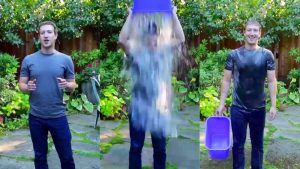
$13.3 million was raised in 2 weeks and 260,000 new donors participated.
June 2014
#IceBucketChallenge begins. The challenge starts but participants choose their own charities — No mention of ALS
July 2014
The Arrival of Pete Frates. Pete Frates changes the conversation and the #IceBucketChallenge becomes #ALSIceBucketChallenge
August 2014
Movement goes viral. $13.3 million was raised in 2 weeks and 260,000 new donors participated.
September 2014
Ice Bucket Challenge loses popularity. Participation begins to decline.
History
Looking at the timeline above, the Ice Bucket Challenge achieved its tipping point as Pete Frates changes the conversation to being a challenge dedicated to ALS research. As more popular figures such as Oprah Winfrey and Mark Zuckerberg partake in the challenge, the challenge goes viral and participants multiply. At its peak, the movement raised 13.3 million dollars in 2 weeks, 260,000 in new donors, as well as 2.2million mentions on twitter. Finally, after a few months, the Ice Bucket Challenge loses its fame and dies down.
While the origins of the movement are unclear, there are a few notable figures who ignited the idea of the movement. The most notable is Chris Kennedy, a golfer from Florida, who initiated the idea but pointed out that people could donate money to the charity/organization of their choice. Chris had challenged his wife’s friend whose husband was diagnosed with ALS. The wife’s friend, Jeanette Senerchia, whose initial motive was to donate money to an ALS-related charity,decided that she was not going to back down from a challenge. “He nominated me as a joke because we bust each other’s chops. I was just going to donate money.”[5] Instead, Senerchia, not to be outdone by Kennedy, accepted the challenge and posted the video on her Facebook page on July 16, nominating more people. This challenge spread rapidly as friends and family members joined in on the challenge and eventually reached an individual by the name of Pete Frates, a Boston College Alumnus who was diagnosed with the disease in March 2012. Frates and his friend, Pat Quinn, who was also diagnosed with the disease took up the challenge using hashtags such as #StrikeOutALS and #Quinnforthewin. What started as a simple idea grew into an international phenomenon resulting in tens of millions of dollars being donated to the research for the cure.
Political spectrum location/affiliation
An article by the Wall Street Journal on the effect of the ALS Ice Bucket Challenge movement stated that, “The ALS Ice Bucket Challenge has swept the nation, raising tens of millions of dollars to fight Lou Gehrig’s Disease. Now, politicians from all parts of the political spectrum, including Ted Cruz, Al Franken and Mitt Romney, have taken the ice-bucket challenge as well, often reaching across political lines to challenge others to partake.” The politicians took on the challenge to demonstrate their stance on the fundraiser.[6]
Key Actors
People
Although the individual(s) responsible for the viral movement are unknown, the person most referred to as the person who ignited the event was Pete Frates who was diagnosed with ALS in 2012 and pioneered the movement. Pete and Pat Quinn, another individual with the disease both created the internet sensation of the Ice Bucket Challenge that expanded world wide.
Social Media Presence
Platforms used
Facebook, Instagram, YouTube, Twitter, Vine.
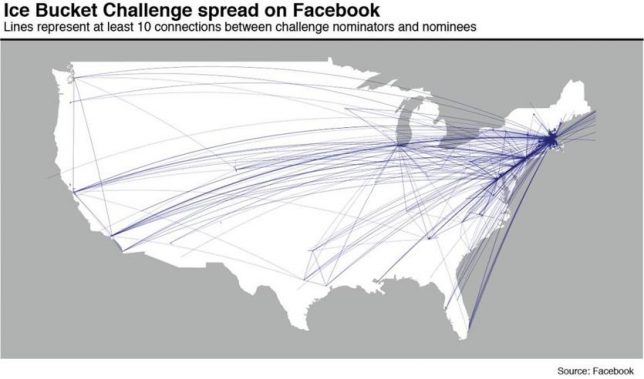
Ice Bucket Challenge Spread on Facebook[7]
From the diagram we observe that movement largely spread from the Boston and New England areas to the rest of the U.S. This is highly indicative of the origins of the movement, as Pete grown and Pat Quinn are both Boston natives, suggesting that the movement was spread organically to friends and neighbors first before gaining widespread media attention that garnered celebrities.
The movement originally began as a video post on Facebook. Many celebrities used twitter to publicize their participation in the movement, and many others chose to post their videos on YouTube and Vine. For the videos that were posted on YouTube and Vine, the participants often made another post on Facebook and Twitter to link that video and tag their challenges. The ability to tag is really important for the movement’s spread among both non-celebrity and celebrity circles, although for celebrities the need is less prevalent as their challenges were often publicized on many news outlets. Specifically, tagging on Facebook and Twitter often gives push-notifications to the targeted individual, giving them timely alerts of the challenge request and allows the IceBucketChallenge to spread more easily within a social circle. Tagging also makes it easy to keep track of who has responded to a challenge, as peers on the social media platform can click the tags, which link to the tagged individual’s profile or page, and see many they have responded to the IceBucketChallenge. The knowledge that one’s participation in the challenge is easily accessible to one’s entire social network may have motivated many to take part in the challenge by a sense of peer pressure and competition.
Popular Hashtags
Some popular hashtags that were used are:
#IceBucketChallenge #ALSIceBucketChallenge #StrikeOutALS
There were no drastic differences in the content and context of tweets using these different hashtags, and indeed many tweets used a combination of two or more (see below). #IceBucketChallenge received the most tweets as it directly relates to the challenge itself, and given that the only notable Ice Bucket Challenge during the movement’s time is the one for ALS, the hashtag #— may have been seen as redundant and unnecessary. Given that Twitter also limits the number of characters in a tweet, the shorter #IceBucketChallenge may have been preferred by many.
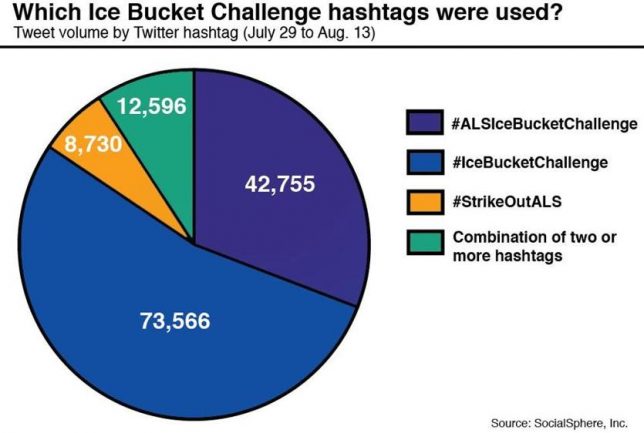
Which Ice Bucket Challenge hashtags were used?[8]
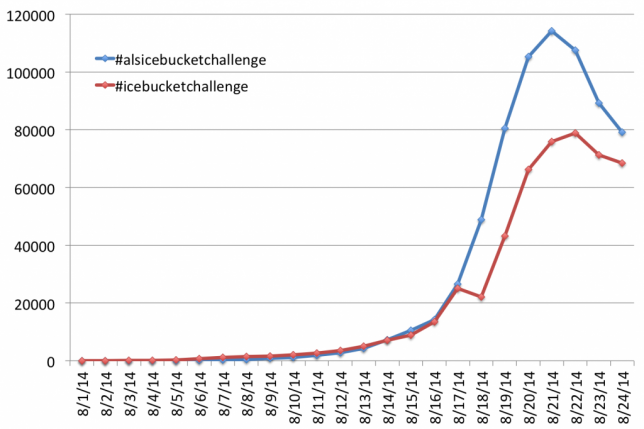
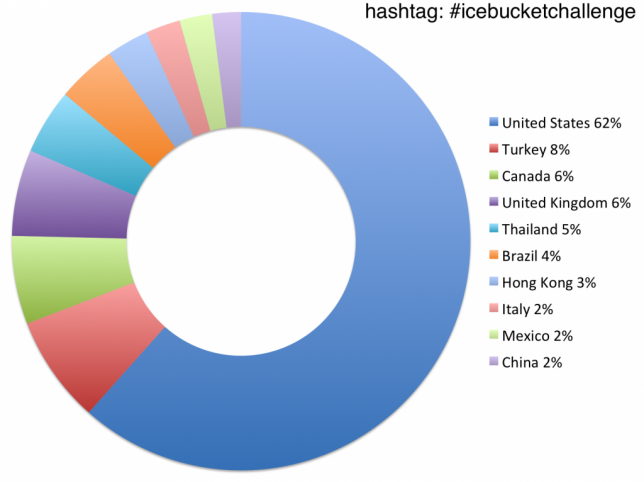
Ice Bucket Challenge Hashtag Stats[9]
From the hashtag usage we also observe that while the U.S. is the main participant in the challenge, the movement did have a substantial following in other countries.
In August 2015, during the second round of ALS Ice Bucket Challenge, the ALS Association along with Quinn and — publicized a new hashtag #EveryAugustUntilACure[10]. In every summer after 2014 revivals and variants of the Ice Bucket Challenge have happened, although with less reach and popularity.
In summer of 2016, a new hashtag, #WhatIsInYourBucket[11] was in use for a variant of the Ice Bucket Challenge that asked participants to use non-water materials for the challenge, with participants choosing iced coffee, cold beer, and beach sand, among others.
Meme vs. Cause
Given the movement’s massive scope and its rapid spread, the original focus on giving donations toward ALS causes sometime has been, at times, ignored. Indeed, as one survey found[12], only 23% of those who participated in the Ice Bucket Challenge actually donated. Toward the second half of the August 2014 numerous parodies of the ALS Ice Bucket challenge began circulating in social media. In response to this and other criticisms about the challenge’s wasteful water usage, Charlie Sheen dumped, instead of a bucket of ice water, a bucket of cash on himself[13], with the motivation of highlighting that the movement should be about giving donations toward ALS causes, and not just the water dumping.
10 Important Social Media Posts
The following are all posts made during the summer of 2014.
Chris Kennedy – July 14th, Youtube.[14]
Chris Kennedy is a pro golfer who performed the Ice Bucket Challenge. Although other pro golfers were performing similar challenges before him, and indeed the term “Ice Bucket Challenge” existed before that, Chris Kennedy’s video was the first that was specifically aimed toward donations for ALS.
Pete Frates – July 31st, Facebook. [15]
Credited as being one of the most important posts that instigated the craze for the movement, Frates’ video was short (less than a minute) and featured no ice buckets. But the post challenged many of Frates’ friends and helped spread the movement in Boston.
So I am nominating myself for the #icebucketchallenge cuz I can…ice water and ALS are a bad mix, so I got my friend Rob Van Winkle to help me out… Julie Frates Nicole Benson Connolly Blair Casey Will MB John Henry Feitelberg Sarah and Matt Ryan, Julian Edelman Tom Brady Toucher & Rich The Howard Stern Show you have 24 hours to dump a bucket of ice over your heads!!#StrikeOutALS #Quinnforthewin
Posted by Pete Frates on Thursday, July 31, 2014
Julian Edelman, August 6th, YouTube.[16]
One of the earliest members of the New England Patriots to accept the challenge and helped to spread awareness in the world of professional sports. The entire New England Patriots followed suit about a week later among other sport teams.
Justin Timberlake, August 11th, Instagram.[17]
Timberlake’s video was spread to over 33 million followers on Instagram at the time of his posting, making it one of the posts with the biggest audience.
Mark Zuckerberg, August 13th, Facebook. [18]
As the founder of Facebook his participation in the challenging, resulting in hundreds of thousands of shares on the platform, validated the movement’s viral status on the social network.
Bill Gates – August 15th, YouTube.[19]
The video has garnered more than 24 million views on Youtube. Gates’ name recognition undoubtedly helped to spread the challenge even further to a wider audience.
Cristiano Ronaldo, August 17th, YouTube.[20]
The video of the Portuguese soccer player with 24 million views brought the attention of the Ice Bucket Challenge to a broader international audience.
George W. Bush, August 20th, YouTube.[21]
With 4 million views on YouTube the former President forwarded the challenge to a round of prominent and retired U.S. politicians.
Benedict Cumberbatch, August 22nd YouTube.[22]
With 7 million views on YouTube the British television and movie star further highlighted the movement’s international reach.
Other celebrities (not a completed list) who also did the challenge in chronological order:
- Chris Christie, August 12th, Facebook[23]
- Jimmy Fallon and guests, August 13th, YouTube[24]
- Conan O’Brien, August 14th, YouTube[25]
- Jeff Bezos, August 15th, YouTube[26]
- Oprah Winfrey, August 15th, Instagram[27]
- Justin Bieber, August 16th, Instagram[28]
- Steven Spielberg, August 16th, YouTube[29]
- Taylor Swift, August 16th, YouTube[30]
- Lebron James, August 17th Instagram[31]
- Lady Gaga, August 18th, Instagram[32]
- Stephen Hawking, August 26th, YouTube[33]
Social Media Impact
Social media is paramount to this movement’s success in that without these platforms, the Ice Bucket Challenge movement would not have grew to the extent that it had and reached so many participants and generate so much donations in the given time frame. Social media networks, especially Facebook, offered a few important advantages that allowed the Ice Bucket Challenge to spread to quickly:
- Low barrier for video uploads: Facebook and Instagram, among other social media platforms, allow video uploads from mobile devices, which many people on social media have. The ease of recording and uploading videos via mobile devices substantially lowers the barrier of entry to participate in the challenge.
- Easy to engage with one’s social circle: the ability to tag the people whom you’re challenging on Facebook made it very easy to bring the attention of the challenge to others. Tagging is essentially effortless and cost-free, so people can tag as many of their friends as they want. Therefore there is little barrier in spreading the challenge quickly through one’s social circle.
- Reciprocity via newsfeed: The video challenging a person to perform the Ice Bucket Challenge is often public to the entirety of the challengees’ social circle on Facebook. This effectively creates a form of peer pressure – if the challengee does not participate, they know that their friends will know that they didn’t. As such, peer pressure on social media helped to motivate many participants to forward the challenge.
- Global audience and participant pool with personalized connections: Facebook at the time of the post had over a billion users, making it a world-wide social media platform. At the same time, the average degrees of separation for any two Facebook users is 3 and a half[34], meaning that any two randomly chosen Facebook users are connected, on average, by less than 4 “friends of friends.” This granted a worldwide audience and participant pool for the Ice Bucket Challenge, but the act of “tagging” friends to challenge them also made each invitation and the subsequent participation in the movement feel personal.
Organic vs. Planned growth
The movement began when Pete Frates posted a video of the first Ice Bucket Challenge on Facebook[35] on July 31st, 2014 – it was not a planned initiative. The founding of the movement, at least the act of making the movement become viral, is often credited to Pete Frates[36] and Pat Quinn[37], both of whom were diagnosed with ALS, and their friend Corey Griffin[38].
Growth of the original movement in the summer 2014 was mostly organic as more than 1.2 million videos have been posted on Facebook with the hashtag #IceBucketChallenge by mid-August 2014, less than a month from the initial video[39]. However, recurrences of the challenge in the following years were re-introduced by a group of ALS organizations in the U.S. in order to raise funding and to establish it as an annual event.
Following that post became a viral trend that lasted a bit over a month (via google trends[40]):

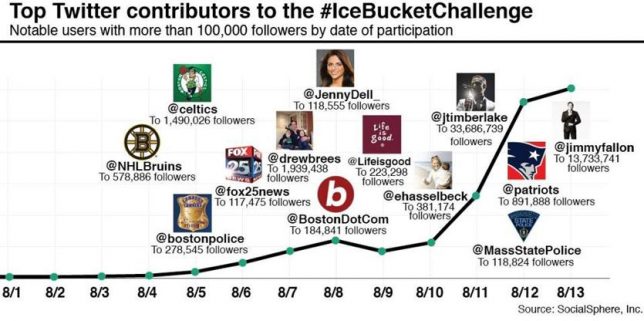
 Top Twitter contributors to the #IceBucketChallenge[41]
Top Twitter contributors to the #IceBucketChallenge[41]
Although the challenge was repeated every August since 2014, those revivals have never triggered the same amount of viral response as the first one. For instance, only 14% of donors who donated in 2014 said that they would donate again in 2015, and in contrast to the $115 million raised by the ALS Association in 2014, they only raised $1 million in 2015 (although that is still significantly higher than donations received in years prior to 2014)[42]
Offline presence
Participation in the challenge, by definition, involves an “offline” presence as people performed the ice water bucket challenge. Many organizations performed the challenge as a group, including sport teams, police departments, and fire departments. Although the ALS Ice Bucket Challenge itself does not specifically motivate an enhanced offline presence, activities organized by the ALS Association, such as “Walk to Defeat ALS,”[43] benefited from the challenge through improved awareness of the cause. In 2017, Pete Frates published a book about the Ice Bucket Challenge detailing his own experience with ALS as well as his involvement in the social movement. Half of the proceeds will go to the Frates family[44].
Analog Antecedents
What groups and other social movements immediately preceded the ALS #IceBucketChallenge?
ALS Organizations
Before the ALS #IceBucketChallenge even began, many nonprofit organizations already existed to raise money and awareness for the disease. Some organizations include the Muscular Dystrophy Association (est. 1950), ALS Association (est. 1985), ALS Therapy Development Institute (est. 1999), Robert Packard Center for ALS Research at Johns Hopkins (est. 1999), Prize4Life (est. 2006), and the Brigance Brigade (est. 2007)[45]. According to their websites, most of these organizations started when their founder or founders were diagnosed with ALS and found that there was no cure–very similar to how the #IceBucketChallenge was started. As of November 29th, 2017, these organizations all take donations through their websites through PayPal or bank transfers.
The ALS Association ended up as the primary receiver of the money raised through the #IceBucketChallenge.
Campaigns for Disease Awareness and Treatment
A number of other organizations starting campaigns to raise money for disease awareness and treatments preceded the #IceBucketChallenge. One organization which is particularly notable is the Susan G. Komen (est. 1982), referred to as Komen, the largest breast cancer awareness organization in the world. According to its website, Komen began their famous Race for the Cure® campaign in the 1980’s, where participants participate in a non-timed 5K or 1-mile walk and ask friends and family to pledge money. Since the campaign began, Komen “funded more than $956 million in research, more than $2.1 billion in medical care, community and provider education, and psychosocial support, serving millions in over 60 countries worldwide.” [46]
Another organization which runs a similar campaign is the National AIDS Trust, otherwise known as the NAT, which
Technological Antecedents
What trends, technologies, and forms of media predated the ALS #IceBucketChallenge social movement?
Instant Communication Technologies
The rise of technologies such as the telephone, radio, satellite television, and the Internet have made the communication of ideas easier and more accessible to greater numbers of people. The Internet in particular made instant communication of words, audio, images, video, and interactive forms of media easy and accessible to anyone with a smart device.
Transmission of Culture: Memetics
Units of “cultural transmission” or “imitation,” which can take the form of “tunes, ideas, catch phrases,” and “fashions,” are denotatively defined as memes,[47] though the connotative definition of the meme immediately brings to mind phenomena such as the spread of graphics and language such as the “much wow” Shiba Inu and “doge.”
Technology has completely changed the channels of human communication, allowing ideas to flow freely from one person to another. As such, memes have evolved into a force of their own. George Rossolatos, an academic researcher and marketing practitioner, explains memes as such: “Just as genes propagate themselves in the gene pool by leaping from body to body via sperms or eggs, so memes propagate themselves in the meme pool by leaping from brain to brain via a process which, in the broad sense, can be called imitation.” [48] Especially in our smartphone-saturated generation, cultural ideas can be distributed by one person to their friends, family and followers with nothing more than a flick of the thumb.
Online memes in the modern age are particularly characterized through their evolution and adaptation for other subjects. For example, the “what in tarnation” meme, which (in its most common form) uses a phrase common to the Southern United States in conjunction with an image of a Shiba Inu with a cowboy hat, was parodied countless times with similar phrases and imagery (“wot n’ hydration?”, “wot n’ annexation?”, “wot n’ germination?”, “wat in reincarnation,” all accompanied by some variant of hat-bearing image). [49]
The #IceBucketChallenge invited its audience to participate and iterate upon a very simple formula for participatory videos.
Viral Videos
Sharing videos was made much easier with the founding of YouTube in 2005.[50] Since then, viral videos, defined as “clip[s] of animation or film that [are] spread rapidly through online sharing,” [51] have become more and more commonplace. Many viral videos become memes, in that they are not only shared and seen commonly, but imitated or parodied.
One great example is that of the Harlem Shake. While the Harlem Shake is known as a dance style, the series of Harlem Shake videos consisted of “a masked individual dancing alone in a group before suddenly cutting to a wild dance party featuring the entire group.” The first Harlem Shake viral video was viewed over 7 million times and imitated over 12,000 times in the first week of its being released. [52] Other examples include Nyan Cat,[53] Shia LeBeouf’s “Just Do It,” [54] and the #RunningManChallenge. [55]
The easily replicability of the #IceBucketChallenge videos allowed them to go viral, bringing the campaign to new audiences with each copied video.
Soliciting Donations Online
Fundraising through small donations made by large amounts of people is an old concept. One project funded in such a manner includes the Statue of Liberty’s pedestal, which was paid for by over 125,000 people thanks to an article published by Joseph Pulitzer in his popular newspaper the New York World. [56]
Crowdfunding is a modernized version of this concept. Made possible in the 21st century by services offered by companies such as Kickstarter and Paypal, it is “a method of collecting many small contributions, by means of an online funding platform, to finance or capitalize a popular enterprise.” [57] Crowdfunding was the primary platform for action by #IceBucketChallenge participants.
Impact
What tangible and intangible impacts did the #IceBucketChallenge leave behind?
Monetary And Research Accomplishments
The #IceBucketChallenge successfully raised enough money in its first iteration[58] to fund six new research projects that led to the discovery of a new gene that contributes to ALS,[59] known as NEK1.[60] In fact, they raised $115 million dollars in their first round of fundraising in the summer of 2014, and $77 million went directly towards research. [61] Since then, they have rekindled the challenge every summer.
Now, there are over 150 labs conducting research on ALS. Research going forward is looking into how exactly the gene leads to the effects of the disease, other possible causes of ALS, and how to find a cure.[62]
Critiques
Performance, Not Impact
The stunt-nature of the Ice Bucket Challenge sometimes overshadowed the actual aim of the movement, which was to generate donations for ALS causes. Some criticized the movement’s focus on performance and not actual impact, with only a few celebrities’ videos explicitly mentioning and encouraging donations toward ALS organizations[63].
Unworthy Cause
Critics[64] say, due to the fact that only a few people are affected by ALS in comparison to other issues, that it seems foolish that ALS can have so much coverage while larger issues go by relatively unnoticed. Estimations predict that about 30,000 Americans may have ALS at any point in time,[65] which is 9.3 * 10-5 percent of all Americans.[66] 5,600 new cases of ALS are diagnosed per year. In contrast, 13.5% of Americans live in poverty;[67] 1.7 million Americans are diagnosed with cancer per year;[68] 11 thousand people die from firearm incidents in the U.S. per year.[69] Many other forms of preventable death are more prevalent than ALS.[70]
Furthermore, most people are subject to moral licensing, a cognitive bias where they believe that previous “good deeds can liberate individuals to engage in behaviors that are immoral, unethical, or otherwise problematic, behaviors that they would otherwise avoid for fear of feeling or appearing immoral.” [71] Critics argue that this cognitive bias made it such that donors to ALS research were less likely to donate elsewhere to more worthy or urgent causes.
Material Waste
The #IceBucketChallenge was mocked for wasting good drinking water. A number of Californian [72] [73] and Henan (China) newspapers[74] criticized the #IceBucketChallenge in 2014 because just earlier that year, California governor Jerry Brown had declared California to be in a “drought state of emergency” [75] and
Henan was experiencing its “worst drought in 63 years.” [76] A counter-campaign, the Rubble Bucket Challenge, was started by Palestinians in Gaza who were unable to even participate in the #IceBucketChallenge due to a lack of electricity to make ice and a dearth of water in the remains of Gaza after an ongoing series of Israeli attacks.[77]
Nothing but Slacktivists
Many people were presumed to only partake in the challenge for virtuous reasons rather than for the original purpose. “Ice-bucket challengers are nothing but slacktivists, it is alleged, using the stunt as a way to feel good about themselves and giving themselves an excuse not to write a check to this cause – or any other – but still feel virtuous.”[78] Just because celebrities, famous individuals, and even friends were participating, some people felt the urge to do the same. That said, even though most people took on the challenge with a good heart, there were some people who participated to follow a trend and to stay relevant.
Conclusion
The ALS Ice Bucket Challenge took the Internet by the storm for a summer in 2014, leveraging the power of social media to quickly achieve viral status and bringing the ALS movement to the forefront of public’s attention. Its fun, engaging nature made the movement memorable, and despite its criticisms, the movement generated hundreds of millions of dollars to fund ALS research and care for ALS patients. The Ice Bucket Challenge perfectly exemplifies the power of social media to amplify a social movement’s presence and reach, and for its goals of raising awareness and funds toward ALS, the movement is a successful one indeed.
Group Members Names, Bios, and Emails
- Sam Chae – samjchae@berkeley.edu | https://www.linkedin.com/in/samchae/
Sam is a fourth year student at UC Berkeley studying Economics and Global Studies. He is interested in the notion of virality and how some videos are able to go viral and what it is about these videos that make them so contagious. He enjoys playing recreational basketball and football with friends. - Jacky Liang – jackyliang@berkeley.edu | https://www.linkedin.com/in/jackyliang42/
Jacky is a fourth year student at UC Berkeley studying Electrical Engineering and Computer Science. He is especially interested in the technologies that enable social networks to grow and connect disparate groups of people, both online and offline, and is excited to learn about the intersection of social movements and technology. - Janny Zhang – jannyzhang@berkeley.edu | https://www.linkedin.com/in/jannyz/
Janny is a 3rd year Electrical Engineering and Computer Science major at UC Berkeley. As a technologist, she loves studying the effect of the digital world on human interactions. She reads, draws, and sings in her free time, and is working towards a career in HCI and public policy.
[1] The ALS Association Rocky Mountain Chapter. “Who Gets ALS?” ALSA.org, 18 Feb. 2014, webco.alsa.org/site/PageServer/?pagename=CO_1_WhoGets.html.
[2] Sifferlin, Alexandra. “ALS Ice Bucket Challenge: How It Started.” Time, Time, 18 Aug. 2014, time.com/3136507/als-ice-bucket-challenge-started/.
[3] Ibid.
[4] Sample, Ian, and Nicky Woolf. “How the Ice Bucket Challenge Led to an ALS Research Breakthrough.” The Guardian, Guardian News and Media, 27 July 2016, www.theguardian.com/science/2016/jul/27/how-the-ice-bucket-challenge-led-to-an-als-research-breakthrough.
[5] Sifferlin, Alexandra. “ALS Ice Bucket Challenge: How It Started.” Time, Time, 18 Aug. 2014, time.com/3136507/als-ice-bucket-challenge-started/.
[6] “’Obamacare’ survives; GOP concedes on last-gasp repeal try.” Yahoo, Yahoo https://www.yahoo.com/news/senators-defect-gop-concedes-health-074408974.html
[7] Cloutier, Catherine. “Facebook: 1.2 Million #IceBucketChallenge Videos Posted – The Boston Globe.” BostonGlobe.com, Boston Globe, 15 Aug. 2014, www.bostonglobe.com/business/2014/08/15/facebook-million-icebucketchallenge-videos-posted/24D8bnxFlrMce5BRTixAEM/story.html.
[8] Ibid.
[9] Clasen, Anthony. “Time Frame of the Viral Ice Bucket Challenge on Instagram.” Iconosquare Blog, 23 Nov. 2017, blog.iconosquare.com/time-frame-viral-ice-bucket-challenge/.
[10] EndPlay. “ALS Supporters Start New Message, ‘Every August until a Cure’.” WSBTV, 16 Aug. 2015, www.wsbtv.com/news/local/als-supporters-start-new-message-every-august-unti/33461289.
[11] Kucharsky, Danny. “Klick Puts a Different Spin on the ALS Ice Bucket Challenge.” Marketing Magazine Klick Puts a Different Spin on the ALS Ice Bucket Challenge Comments, 28 July 2016, marketingmag.ca/advertising/klick-puts-a-different-spin-on-the-als-ice-bucket-challenge-180340/.
[12] Treato. “ALS Ice Bucket Challenge One Year Later.” PR Newswire: News Distribution, Targeting and Monitoring, 15 July 2015, www.prnewswire.com/news-releases/als-ice-bucket-challenge-one-year-later-515299371.html.
[13] Monde, Chiderah. “Charlie Sheen Does ALS Bucket Challenge with Cash Instead of Ice.” NY Daily News, NEW YORK DAILY NEWS, 19 Aug. 2014, www.nydailynews.com/entertainment/gossip/charlie-sheen-als-bucket-challenge-cash-ice-article-1.1908475.
[14] Kennedy, Chris. “CK Ice Bucket Challenge.” YouTube, 15 July 2014, youtu.be/WpJCWjs6kYA.
[15] Frates, Pete. “Pete Frates.” Pete Frates – So I Am Nominating Myself for the…, www.facebook.com/photo.php?v=10100972302395017.
[16] Vittorni, Frankie. “Julian Edelman’s ALS Ice Water Challenge – Nominates Amendola, Gronk, & Brady.” YouTube, YouTube, 6 Aug. 2014, www.youtube.com/?app=desktop.
[17] Timberlake, Justin. “Instagram Post by Justin Timberlake • Aug 12, 2014 at 1:23am UTC.”Instagram, www.instagram.com/p/rlGTWjydmt/.
[18] Zuckerberg, Mark. “Mark Zuckerberg.” Mark Zuckerberg – Yesterday, Governor Chris Christie…, 13 Aug. 2014, www.facebook.com/zuck/videos/10101586925575221/.
[19] thegatesnotes. “Bill Gates ALS Ice Bucket Challenge.” YouTube, YouTube, 15 Aug. 2014, www.youtube.com/watch?v=XS6ysDFTbLU.
[20] Ronaldo, Cristiano. “Cristiano Ronaldo #Icebucketchallenge.” YouTube, YouTube, 17 Aug. 2014, www.youtube.com/?app=desktop.
[21] ALS. “ALS Ice Bucket Challenge – George W. Bush.” YouTube, YouTube, 20 Aug. 2014, www.youtube.com/watch?v=DepakUSDtQE.
[22] MND Association. “Benedict Cumberbatch’s Ice Bucket Challenge for #MND.” YouTube, YouTube, 22 Aug. 2014, www.youtube.com/watch?v=YOa7ZjxRuKM.
[23] Christie, Chris. “Governor Chris Christie.” I’m Accepting the Team FrateTrain… – Governor Chris Christie, 12 Aug. 2014, www.facebook.com/GovChrisChristie/videos/10154504678515389/.
[24] latenight. “Rob Riggle, Horatio Sanz, Steve Higgins, The Roots, & Jimmy Take the ALS Ice Bucket Challenge.” YouTube, YouTube, 13 Aug. 2014, www.youtube.com/watch?v=b_kdke345NQ.
[25] Conan. “Conan Takes The ALS Ice Bucket Challenge.” YouTube, YouTube, 14 Aug. 2014, www.youtube.com/?app=desktop.
[26] amazon. “Jeff Bezos Accepts the ALS Ice Bucket Challenge #IceBucketChallenge.” YouTube, YouTube, 15 Aug. 2014, www.youtube.com/watch?v=DFVezzjAhFY.
[27] Winfrey, Oprah. “Instagram Post by Oprah • Aug 16, 2014 at 2:19am UTC.” Instagram, 15 Aug. 2014, www.instagram.com/p/rvf4MayS5p/.
[28] Bieber, Justin. “Kids React to Ice Bucket Challenge : Fine Brothers Entertainment : Free Download & Streaming.” Internet Archive, 31 Aug. 2014, archive.org/details/TheFineBros-289_20140831.
[29] the100footjourney. “Steven Spielberg Accepts The ALS Ice Bucket Challenge From Oprah Winfrey.” YouTube, YouTube, 16 Aug. 2014, www.youtube.com/watch?v=QFF6EWVSACE.
[30] Proudoftay, Laura. “Taylor Swift Ice Bucket Challenge.” YouTube, YouTube, 16 Aug. 2014, www.youtube.com/?app=desktop.
[31] James, kingjames. #ALSIceBucketChallenge. Instagram, 17 August. 2014, https://www.instagram.com/p/rzLh7nCTEk/
[32] Germanotta, ladygaga. #ALSIceBucketChallenge. Instagram, 18 August. 2014, https://www.instagram.com/p/r1uvbnJFNv/
[33] AlloD. “Professor Stephen Hawking ALS Ice Bucket Challenge (Official Video).” YouTube, 26 August. 2014, youtu.be/gK645_7TA6c.
[34] “Three and a half degrees of separation.” Facebook Research, research.fb.com/three-and-a-half-degrees-of-separation/.
[35] Frates, Peter. “ALSIceBucketChallenge Nomination.” Facebook, 31 July. 2014, https://www.facebook.com/photo.php?v=10100972302395017
[36] Goldberg, Eleanor. “Meet The Guy Who Made ALS ‘Ice Bucket Challenge’ Go Viral.” The Huffington Post, TheHuffingtonPost.com, 15 Aug. 2014, www.huffingtonpost.com/2014/08/15/pete-frates-ice-bucket-challenge-_n_5683074.html.
[37] Levin, Josh. “Who Invented the Ice Bucket Challenge? A Slate Investigation.” Slate Magazine, 22 Aug. 2014, www.slate.com/articles/technology/technology/2014/08/who_invented_the_ice_bucket_challenge_a_slate_investigation.single.html.
[38] Ap. “Corey Griffin, 27; left his mark in everything from friendship to philanthropy – The Boston Globe.” BostonGlobe.com, 20 Aug. 2014, www.bostonglobe.com/metro/obituaries/2014/08/19/corey-griffin-left-his-mark-everything-from-friendship-philanthropy/ahbexfXQNqgIbaWTJ3nEtN/story.html.
[39] “Facebook: 1.2 million #IceBucketChallenge videos posted – The Boston Globe.” BostonGlobe.com, 15 Aug. 2014, www.bostonglobe.com/business/2014/08/15/facebook-million-icebucketchallenge-videos-posted/24D8bnxFlrMce5BRTixAEM/story.html.
[40] Danny Kucharsky July 28, 2016. “Klick puts a different spin on the ALS Ice Bucket Challenge.” Marketing Magazine Klick puts a different spin on the ALS Ice Bucket Challenge Comments, marketingmag.ca/advertising/klick-puts-a-different-spin-on-the-als-ice-bucket-challenge-180340/.
[41] “Facebook: 1.2 million #IceBucketChallenge videos posted – The Boston Globe.” BostonGlobe.com, 15 Aug. 2014, www.bostonglobe.com/business/2014/08/15/facebook-million-icebucketchallenge-videos-posted/24D8bnxFlrMce5BRTixAEM/story.html.
[42] Danny Kucharsky July 28, 2016. “Klick puts a different spin on the ALS Ice Bucket Challenge.” Marketing Magazine Klick puts a different spin on the ALS Ice Bucket Challenge Comments, marketingmag.ca/advertising/klick-puts-a-different-spin-on-the-als-ice-bucket-challenge-180340/.
[43] “The time is now to defeat ALS!” The ALS Association’s – The ALS Association, walktodefeatals.org/.
[44]“The Ice Bucket Challenge: Pete Frates and the Fight against ALS Paperback – September 5, 2017.” The Ice Bucket Challenge: Pete Frates and the Fight against ALS: Casey Sherman, Dave Wedge: 9781512600964: Amazon.Com: Books, www.amazon.com/Ice-Bucket-Challenge-Frates-against/dp/1512600962.
[45] “About ALS.” Brigance Brigade, www.brigancebrigade.org/about-als/other-als-organizations.
[46] “Our Mandate at Susan G. Komen®.” Susan G. Komen®, ww5.komen.org/ourimpact/.
[47] Rossolatos, George. “The Ice-Bucket Challenge: The Legitimacy of the Memetic Mode of Cultural Reproduction Is the Message.” University of Kassel, 2015, http://www.journals.uchicago.edu/doi/pdfplus/10.1086/679520
[48] Ibid.
[49] “What in Tarnation.” Know Your Meme, 10 Dec. 2017, knowyourmeme.com/memes/what-in-tarnation.
[50] Bellis, Mary. “Who Invented YouTube?” ThoughtCo, www.thoughtco.com/who-invented-youtube-1992691.
[51] “What is a Viral Video? – Definition from Techopedia.” Techopedia.com, www.techopedia.com/definition/26863/viral-video.
[52] “Harlem Shake.” Know Your Meme, 11 Dec. 2017, knowyourmeme.com/memes/harlem-shake.
[53] “Nyan Cat / Pop Tart Cat.” Know Your Meme, 8 Nov. 2017, knowyourmeme.com/memes/nyan-cat-pop-tart-cat.
[54] “Shia LaBeouf’s Intense Motivational Speech / Just Do It.” Know Your Meme, 11 Dec. 2017, knowyourmeme.com/memes/shia-labeouf-s-intense-motivational-speech-just-do-it.
[55] “Running Man.” Know Your Meme, Literally Media Ltd., 23 Dec. 2016, knowyourmeme.com/memes/running-man.
[56] “Joseph Pulitzer.” National Parks Service, U.S. Department of the Interior, 26 Feb. 2015, www.nps.gov/stli/learn/historyculture/joseph-pulitzer.htm.
[57] Freedman, David M, and Matthew R Nutting. “A Brief History of Crowdfunding.” 5 Nov. 2015.
[58] Rogers, Katie. “The ‘Ice Bucket Challenge’ Helped Scientists Discover a New Gene Tied to A.L.S.” New York Times, 27 July 2016.
[59] “Ice Bucket Challenge Funds Gene Discovery in ALS (MND) Research.” BBC News, BBC, 27 July 2016, www.bbc.com/news/health-36901867.
[60] Kenna, Kevin P, et al. “NEK1 Variants Confer Susceptibility to Amyotrophic Lateral Sclerosis.” Nature News, Nature Publishing Group, 25 July 2016, www.nature.com/articles/ng.3626.
[61] “Your Ice Bucket Dollars at Work.” ALSA.org, The ALS Association, www.alsa.org/fight-als/ibc-infographic.html.
[62] “Research We Fund.” ALSA.org, The ALS Association, www.alsa.org/fight-als/ibc-infographic.html.
[63] “Steve-O Takes Aim at Stars over Ice Bucket Challenge.” Entertainment – MSN CA, 19 Aug. 2014, web.archive.org/web/20140820224752/http://entertainment.ca.msn.com/celebs/steve-o-takes-aim-at-stars-over-ice-bucket-challenge-1.
[64] MacAskill, William. “The cold, hard truth about the ice bucket challenge.” Quartz, 14 Aug. 2014, https://qz.com/249649/the-cold-hard-truth-about-the-ice-bucket-challenge/.
[65] “Incidence of ALS.” University of California — San Diego School of Medicine, n.d., http://als.ucsd.edu/about-als/Pages/incidence.aspx.
[66] https://www.census.gov/programs-surveys/popest.html.
[67] “Population and Housing Unit Estimates.” United States Census Bureau, n.d., https://poverty.ucdavis.edu/faq/what-current-poverty-rate-united-states.
[68] “Cancer Statistics.” National Cancer Institute, n.d., https://www.cancer.gov/about-cancer/understanding/statistics.
[69] “Guns in the US: The statistics behind the violence.” BBC News, BBC; 5 Jan. 2016, http://www.bbc.com/news/world-us-canada-34996604.
[70] Dhar, Rohin. “Ugly Charts About Guns in America.” Priceonomics, n.d., https://priceonomics.com/post/43742280185/ugly-charts-about-guns-in-america.
[71] C. Merritt, Anna & Effron, Daniel & Monin, Benoît. (2010). Moral Self‐Licensing: When Being Good Frees Us to Be Bad. Social and Personality Psychology Compass. 4. 344 – 357. 10.1111/j.1751-9004.2010.00263.x.
[72] Stevens, Matt. “Ice Bucket Challenge stirs controversy in drought-plagued California.” Los Angeles Times, 20 Aug. 2014, http://www.latimes.com/local/lanow/la-me-ln-ice-bucket-challenge-water-drought-20140819-story.html.
[73] Rose, Steve. “Ice bucket challenge: who’s pouring cold water on the idea?” The Guardian, 25 Aug. 2014, https://www.theguardian.com/world/shortcuts/2014/aug/25/ice-bucket-challenge-drought-henan-california-animal-rights-rice.
[74] “LOOK: Residents in drought-stricken Henan protest Ice Bucket Challenge, dub it ‘wasteful’.” Shanghaiist, 24 Aug. 2014, http://shanghaiist.com/2014/08/24/residents_in_drought-striken_henan.php.
[75] “California Drought.” U.S. Department of the Interior, 31 May 2017, https://ca.water.usgs.gov/data/drought/.
[76] “Henan province faces worst drought in 63 years.” Chinese Central Television, 2 Aug 2014, http://english.cntv.cn/2014/08/02/VIDE1406985363675923.shtml.
[77] Toor, Amar. “Rubble Bucket Challenge aims to raise awareness about Gaza.” The Verge, 26 Aug. 2014, https://www.theverge.com/2014/8/26/6068763/rubble-bucket-challenge-aims-to-raise-awareness-about-gaza.
[78] McGee, Suzanne. “The ice bucket challenge for ALS is a gimmick – and it’ good.” The Guardian, 17 Aug. 2014, https://www.theguardian.com/money/us-money-blog/2014/aug/17/ice-bucket-challenge-als-stunt-gimmick-good.
